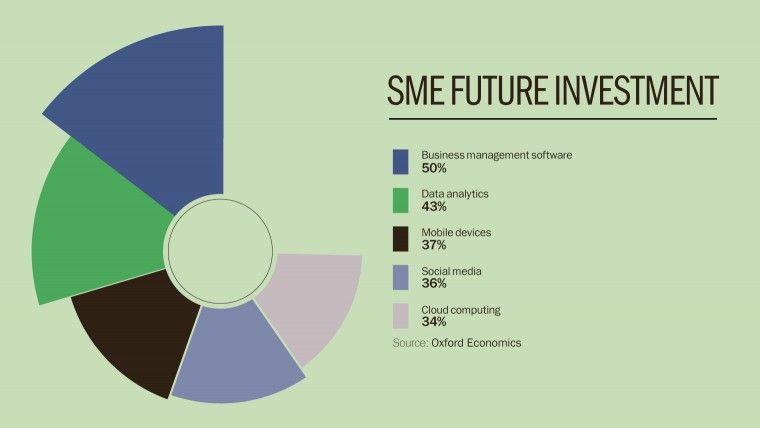Data may now be perceived as “big”, but that does not mean it’s only for large enterprises. With the proliferation of internet-enabled technologies, such as mobile, social media and the internet of things, having less revenue and fewer people no longer means you have less information.
In fact, a recent report by Research and Markets forecasts that the global big data market for small and medium-sized enterprises (SMEs) will grow at a compound annual rate of 43 per cent until 2018.

Just like large enterprises, SMEs can use big data to better understand their customers, tap into new markets and cut out unnecessary costs across the business, all in real-time. However, when you start collecting and storing all the data available, which can quickly reach petabytes in volume, having the capital to invest in the associated hardware and software can create a real problem for mid-market firms.
Cloud computing, the ability to rent compute power from an external provider as and when you need it, may provide SMEs with the solution. Clive Longbottom, founder of analyst group Quorcirca, says SMEs should absolutely be taking advantage of big data and that the cloud is the perfect place to do it.
“Cloud can provide a far more cost-effective platform for building big data analytics,” he says. “Rather than trying to do it all in-house, going for an open and flexible big data analytics capability in the cloud means the mid-market organisation can focus on what it should focus on – the business – while letting the grease-monkey work of maintaining the platform be looked after by someone else. It also allows for peaks and troughs in workload to be more easily dealt with.”
This is certainly the case for MobFox, a rapidly growing mobile advertising platform that has offices in London, Paris and Vienna. Chief executive Julian Zehetmayr says big data analytics is crucial to the firm’s existence as the business relies on understanding user behaviour on mobile applications to serve up targeted ads in real-time.
“When you display 30 billion ads a month, there’s a lot of data,” he says. “We use big data to analyse how relevant an ad is to a user at any given time. As soon as you open an app on your phone, we get a lot of information about you; we take all this data and combine it with data we already have from previous campaigns. We then try to find out how likely you are to click on a specific ad and how likely you are to make a purchase after you click.”
The cloud is a useful tool for SMEs that want to be able to control how they scale their big data function
These complex analytics are being carried out on a Hadoop system, an open-source platform that was originally developed by Google to process large-scale datasets. However, instead of running all this internally, MobFox does it in the cloud.
“Over 90 per cent of our whole infrastructure is run in SoftLayer’s cloud. This is important because, if we brought on a really large client tomorrow, that could instantly double the amount of requests we are doing today,” says Mr Zehetmayr.
“But with the cloud, if we need to double the infrastructure quickly, we could do that within an hour. Also, if we want to go back to the current state, that’s possible as well. So it’s about being able to scale up and down really quickly.”
It’s obvious that the cloud is a useful tool for SMEs that want to be able to control how they scale their big data function. However, that doesn’t mean that it comes without its challenges. Craig Bloodworth, chief technology officer at big data consultants The Information Lab, warns SMEs need to be aware of spiralling costs.
“Cost can be a double-edged sword,” he says. “It’s fantastic that you can spin up instances as and when you need them, but if you don’t have a handle on your usage and your billing rates, then you can find yourself paying a lot for cloud-based data storage.
“For example, some providers will charge you very little for storage, but they will charge you for querying it. So if you’re constantly querying it every single minute, then it’s going to start costing you a lot of money.”
Also, while the cloud may allow you to employ fewer people, as you don’t have to manage all the kit in-house, there is usually the need for a dedicated data scientist. However, Dr Chris Harding, director of interoperability at The Open Group, a consortium that aims to promote quality IT standards, warns that finding these skills could be a challenge.
“Someone like a data scientist is going to be very important to an SME. The scenario that we see with enterprises using big data is they don’t necessarily know what they are looking for when they start off, and so there is a need for someone who understands the business, but who also understands the technology and the science. They will need people of that kind and those people are not in massively large supply at the moment,” he says.


